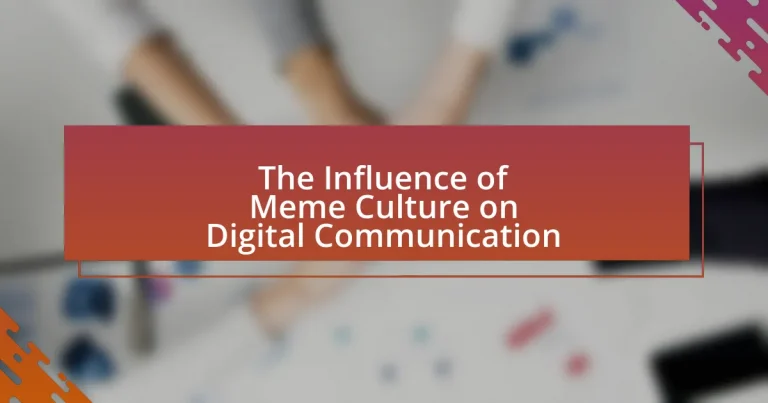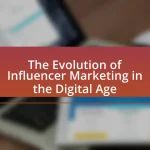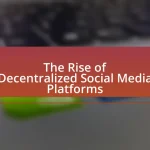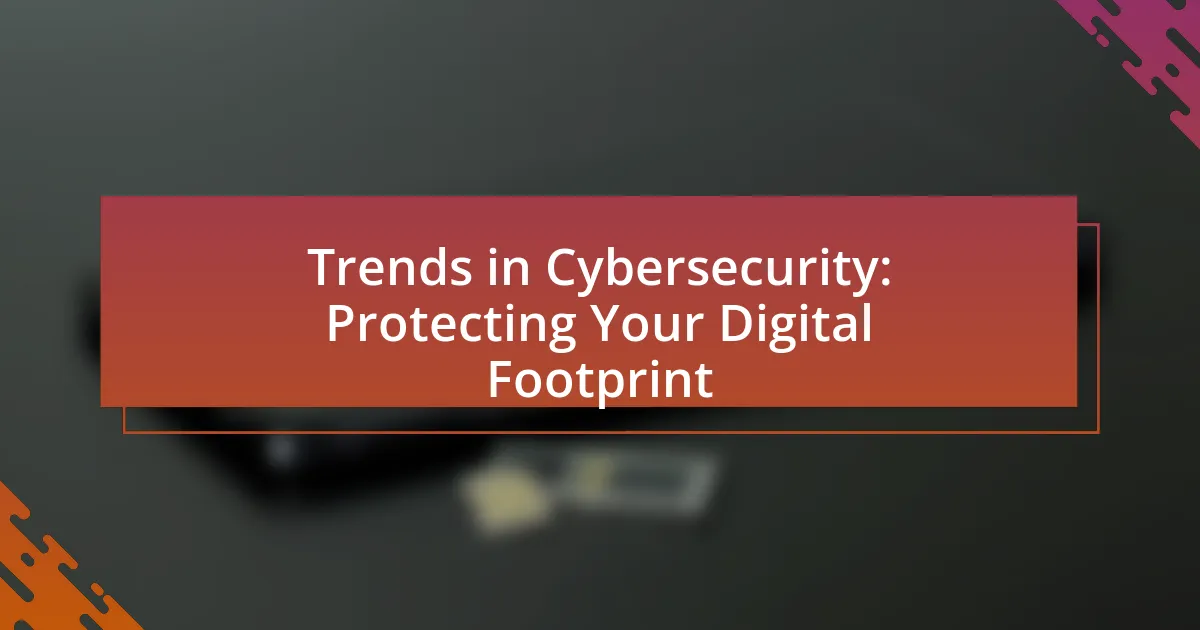Meme culture plays a significant role in shaping digital communication by influencing how individuals express ideas, emotions, and social commentary. Memes serve as a shorthand for conveying complex messages quickly, enhancing engagement on social media platforms and fostering a shared language among users. The article explores the evolution of meme culture, its key characteristics, and its impact on public opinion, information dissemination, and emotional responses in digital interactions. Additionally, it addresses the challenges and ethical considerations associated with meme sharing and creation, while providing best practices for effective use in online discussions.
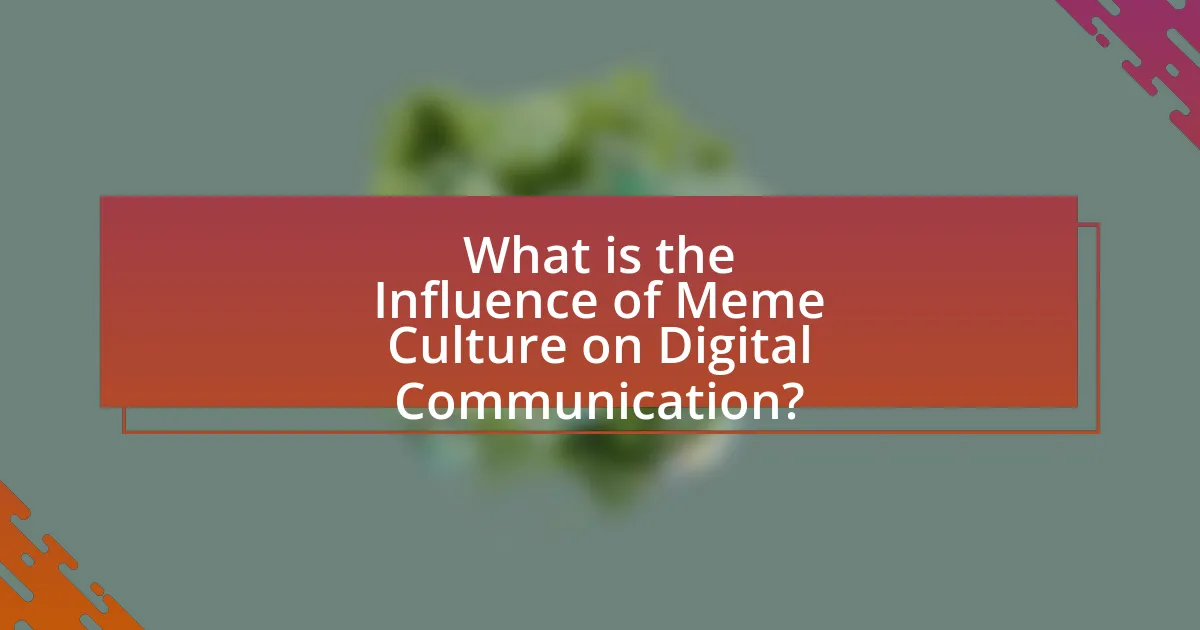
What is the Influence of Meme Culture on Digital Communication?
Meme culture significantly influences digital communication by shaping how individuals express ideas, emotions, and social commentary. Memes serve as a form of shorthand, allowing users to convey complex messages quickly and effectively, often relying on humor or irony. Research indicates that memes enhance engagement on social media platforms; for instance, a study published in the journal “Computers in Human Behavior” found that posts containing memes receive 50% more shares than text-only posts. This increased shareability fosters a rapid spread of information and cultural references, creating a shared language among users. Consequently, meme culture not only alters the dynamics of online interactions but also impacts the way information is perceived and disseminated in the digital landscape.
How has meme culture evolved in the digital age?
Meme culture has evolved significantly in the digital age by transitioning from simple image-based humor to complex, multi-layered forms of communication that reflect societal trends and issues. Initially, memes were primarily static images with text, often shared on platforms like 4chan and Reddit. As social media platforms like Twitter, Instagram, and TikTok gained popularity, memes became more dynamic, incorporating videos, GIFs, and interactive content, allowing for rapid dissemination and adaptation.
The rise of user-generated content has also contributed to the evolution of meme culture, as individuals can now create and share memes instantly, leading to viral trends that can influence public discourse. For example, the “Distracted Boyfriend” meme became a global phenomenon, illustrating how a single image can be repurposed to comment on various social issues, from relationships to political commentary.
Furthermore, the integration of memes into marketing strategies by brands demonstrates their impact on digital communication. Companies leverage memes to engage younger audiences, as seen in campaigns that utilize popular meme formats to resonate with consumers. This shift highlights how memes have transcended mere entertainment to become a vital tool for communication and expression in the digital landscape.
What are the key characteristics of memes that facilitate communication?
Memes possess key characteristics that facilitate communication, including relatability, humor, and visual appeal. Relatability allows individuals to connect with shared experiences or sentiments, making the message more impactful. Humor engages audiences, often leading to increased sharing and interaction, as seen in studies showing that humorous content is more likely to go viral. Visual appeal captures attention quickly, as images are processed faster than text, enhancing comprehension and retention of the message. These characteristics collectively enhance the effectiveness of memes in conveying ideas and emotions in digital communication.
How do memes reflect cultural trends and societal issues?
Memes reflect cultural trends and societal issues by serving as a visual language that encapsulates shared experiences, beliefs, and emotions within a community. They often address current events, social movements, and popular culture, allowing individuals to express their perspectives in a relatable and humorous manner. For instance, during the Black Lives Matter movement, memes highlighting racial injustice gained traction, illustrating public sentiment and mobilizing support. Research by Limor Shifman in “Memes in Digital Culture” emphasizes that memes act as a form of social commentary, enabling users to engage with and critique societal norms. This demonstrates how memes not only mirror but also shape cultural discourse, making them a powerful tool for reflection and communication in the digital age.
Why is meme culture significant in modern communication?
Meme culture is significant in modern communication because it serves as a rapid and effective means of conveying complex ideas, emotions, and social commentary in a visually engaging format. Memes often encapsulate cultural references and humor, making them easily shareable and relatable across diverse audiences. For instance, a study by the Pew Research Center found that 55% of online adults have shared a meme, highlighting their role in facilitating conversations and fostering community engagement. This widespread sharing demonstrates how memes can influence public discourse and shape societal narratives, making them a powerful tool in digital communication.
What role do memes play in shaping public opinion?
Memes play a significant role in shaping public opinion by simplifying complex ideas and making them easily shareable across social media platforms. This simplification allows for rapid dissemination of information, influencing perceptions and attitudes on various issues. Research indicates that memes can reinforce existing beliefs or challenge them by presenting information in a humorous or relatable format, which can lead to increased engagement and discussion among users. For example, a study published in the journal “Computers in Human Behavior” found that memes can effectively sway political opinions by framing issues in a way that resonates with specific audiences, demonstrating their power in the digital communication landscape.
How do memes contribute to the spread of information and misinformation?
Memes significantly contribute to the spread of both information and misinformation by simplifying complex ideas into easily digestible formats that can be rapidly shared across social media platforms. Their visual nature and humor make them highly engaging, which increases the likelihood of users sharing them, thereby amplifying their reach. Research indicates that memes can distort facts or present misleading narratives, as seen in the 2016 U.S. presidential election, where memes played a crucial role in disseminating false information, influencing public perception and voter behavior. This dual capacity of memes to inform and misinform highlights their powerful role in shaping digital communication.
What are the psychological effects of memes on communication?
Memes significantly influence communication by shaping social interactions and emotional responses. They serve as a form of shorthand, allowing individuals to convey complex ideas or emotions quickly and effectively. Research indicates that memes can enhance relatability and foster a sense of community among users, as they often reflect shared experiences or cultural references. For instance, a study published in the journal “Computers in Human Behavior” found that memes can evoke laughter and reduce stress, thereby improving interpersonal communication and social bonding. Additionally, memes can also perpetuate stereotypes or misinformation, impacting perceptions and attitudes within a group. Thus, while memes can facilitate connection and understanding, they also carry the potential for negative psychological effects on communication.
How do memes influence emotional responses in digital interactions?
Memes significantly influence emotional responses in digital interactions by evoking humor, relatability, and shared cultural references. This emotional engagement occurs because memes often encapsulate complex feelings or social commentary in a simple, visual format, making them easily digestible and shareable. Research indicates that memes can enhance feelings of connection and community among users, as they often reflect collective experiences or sentiments, thereby fostering a sense of belonging. For instance, a study published in the journal “Computers in Human Behavior” found that memes can trigger laughter and positive emotions, which in turn can lead to increased social interaction and bonding among individuals in online spaces.
What cognitive processes are involved in meme consumption and sharing?
Meme consumption and sharing involve several cognitive processes, including attention, interpretation, and social cognition. Attention is critical as individuals must first notice a meme among the vast amount of digital content. Interpretation follows, where users decode the visual and textual elements of the meme, often relying on prior knowledge and cultural context to understand its humor or message. Social cognition plays a significant role as individuals assess the social implications of sharing a meme, considering how it aligns with their identity and the potential reactions from their social network. Research indicates that memes often utilize humor and relatability, which enhances their shareability and engagement, as seen in studies examining the virality of memes on platforms like Twitter and Instagram.
How does meme culture impact various demographics?
Meme culture significantly impacts various demographics by shaping communication styles, social interactions, and cultural references. For instance, younger generations, particularly Gen Z and Millennials, utilize memes as a primary form of expression and social commentary, often reflecting their values and experiences. Research indicates that 55% of Gen Z uses memes to communicate emotions and opinions, highlighting their role in digital conversations. Additionally, memes can bridge cultural gaps, as they often transcend language barriers, allowing diverse groups to connect over shared humor or experiences. This phenomenon is evident in the global spread of memes, where localized adaptations resonate with different cultural contexts, fostering a sense of community among users.
What differences exist in meme usage among age groups?
Meme usage varies significantly among age groups, with younger individuals, particularly those aged 18-29, engaging more frequently and creatively with memes compared to older demographics. Research indicates that younger users are more likely to create and share memes on platforms like TikTok and Instagram, while older users, such as those aged 30-49, tend to consume memes rather than create them, often sharing content found on Facebook. A study by the Pew Research Center in 2021 found that 69% of adults aged 18-29 reported using memes regularly, while only 34% of those aged 50 and older did the same. This disparity highlights the generational differences in both the creation and consumption of meme content, reflecting broader trends in digital communication preferences across age groups.
How do cultural backgrounds affect meme interpretation and creation?
Cultural backgrounds significantly influence meme interpretation and creation by shaping the context, humor, and references that resonate with individuals. For instance, memes often rely on cultural symbols, language nuances, and societal norms that vary across different cultures, leading to diverse interpretations. Research indicates that memes rooted in specific cultural contexts can be misinterpreted or lose their intended humor when viewed by individuals from different backgrounds. A study by Shifman (2014) highlights how cultural familiarity enhances the effectiveness of memes, as audiences are more likely to engage with content that reflects their own experiences and values. Thus, cultural backgrounds play a crucial role in determining how memes are understood and created, affecting their overall impact in digital communication.
What challenges does meme culture present in digital communication?
Meme culture presents several challenges in digital communication, primarily including misinterpretation, oversimplification of complex issues, and the potential for spreading misinformation. Misinterpretation occurs because memes often rely on cultural references or humor that may not be universally understood, leading to confusion among diverse audiences. Oversimplification happens when nuanced topics are reduced to simplistic images or phrases, which can distort the original message and hinder meaningful discourse. Furthermore, the rapid sharing of memes can facilitate the spread of misinformation, as users may share content without verifying its accuracy, contributing to the proliferation of false narratives. These challenges highlight the complexities of conveying messages effectively in a digital landscape dominated by meme culture.
How can memes lead to misunderstandings or conflicts in communication?
Memes can lead to misunderstandings or conflicts in communication due to their reliance on cultural context and humor, which may not be universally understood. When individuals interpret memes based on their own experiences or cultural backgrounds, they may misinterpret the intended message, leading to confusion or offense. For example, a meme that uses irony or sarcasm may be taken literally by someone unfamiliar with that style of humor, resulting in a conflict over the perceived meaning. Additionally, the rapid spread of memes can amplify these misunderstandings, as they often lack accompanying explanations, making it difficult for recipients to grasp the original context.
What ethical considerations arise from meme sharing and creation?
Ethical considerations in meme sharing and creation include issues of copyright infringement, misinformation, and the potential for harm through offensive content. Copyright infringement arises when creators use copyrighted images or videos without permission, leading to legal consequences. Misinformation can spread rapidly through memes, as they often simplify complex issues, potentially misleading audiences. Additionally, memes can perpetuate stereotypes or promote hate speech, causing emotional or psychological harm to individuals or groups. These ethical concerns highlight the need for responsible meme creation and sharing practices to mitigate negative impacts on society.
How can individuals effectively use memes in digital communication?
Individuals can effectively use memes in digital communication by ensuring that the memes are relevant to the audience and context. Memes serve as a powerful tool for conveying humor, emotions, and cultural references, which can enhance engagement and relatability in conversations. Research indicates that memes can increase message retention and sharing rates, as they often encapsulate complex ideas in a simple, visual format. For instance, a study published in the journal “Computers in Human Behavior” found that humorous content, including memes, significantly boosts user interaction on social media platforms. By aligning memes with current trends and cultural touchpoints, individuals can foster a sense of community and connection, making their digital communication more impactful.
What best practices should be followed when creating and sharing memes?
When creating and sharing memes, it is essential to ensure originality, relevance, and clarity. Originality prevents copyright issues and fosters creativity, while relevance ensures the meme resonates with the intended audience, enhancing engagement. Clarity in visuals and text is crucial for effective communication, as memes often rely on quick comprehension.
Additionally, adhering to platform guidelines and understanding the cultural context of the meme can prevent misunderstandings and promote positive interactions. Research indicates that memes that align with current trends and social issues tend to achieve higher engagement rates, as seen in studies analyzing viral content on social media platforms.
How can memes enhance engagement in online discussions?
Memes enhance engagement in online discussions by providing relatable humor and visual appeal that captures attention. Their concise format allows for quick communication of complex ideas, making them easily shareable and memorable. Research indicates that posts containing images, including memes, receive 94% more views than text-only posts, demonstrating their effectiveness in increasing interaction. Additionally, memes foster a sense of community and shared understanding among users, encouraging participation and dialogue.
